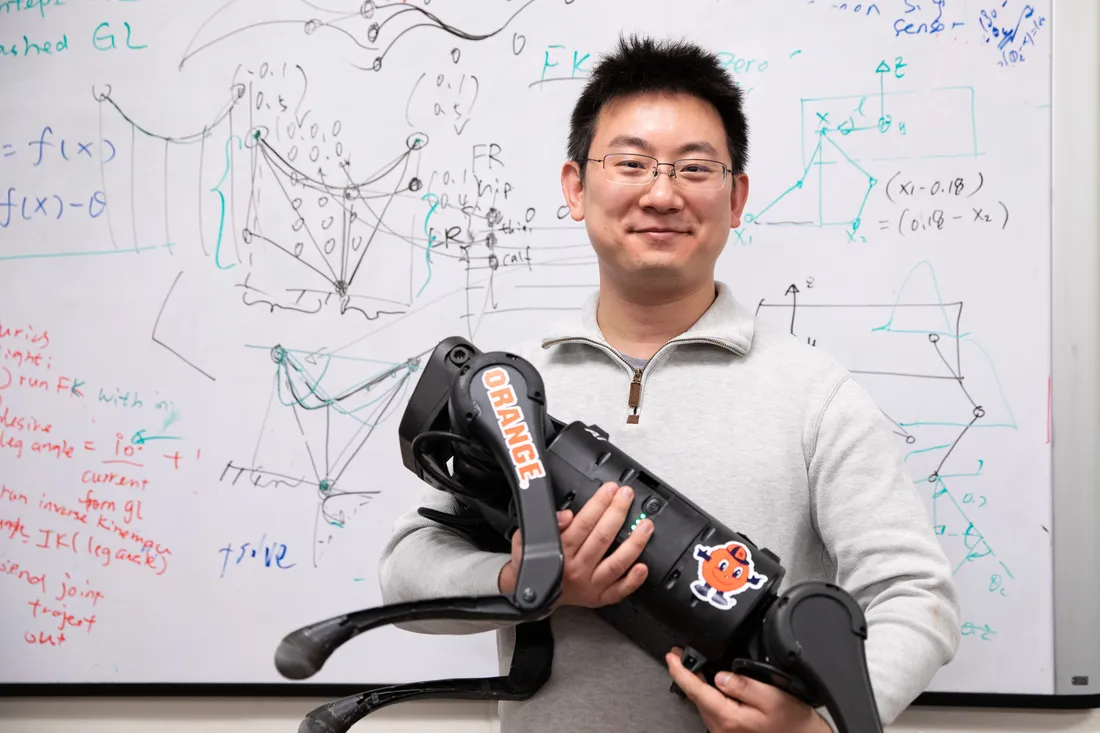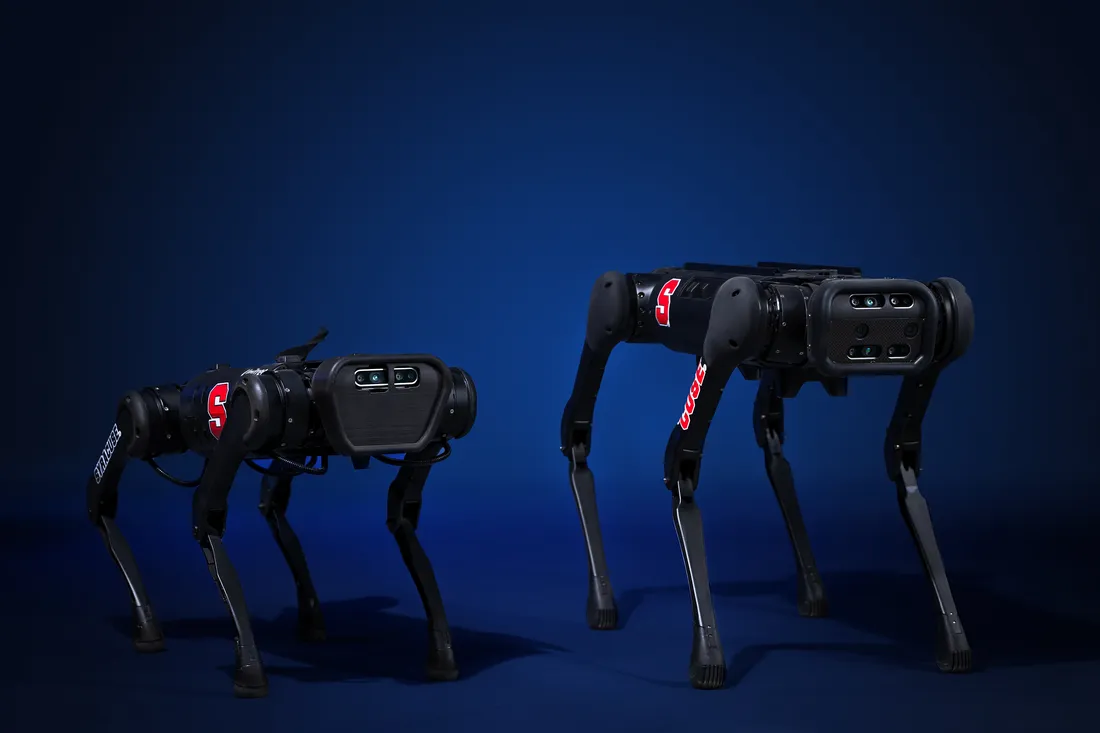The Fire Department of the City of New York (FDNY) recently made headlines with the hiring of two prized recruits. Only the firefighters in question weren’t humans; they were robots. Robot dogs, to be exact.
Billed as the “future of fire safety and rescue,” the computerized canines crawl into burning and collapsed buildings to retrieve victims. They also can detect radiological and nuclear material, toxic gas and other hazardous material.

Robot dogs come in all shapes and sizes and, at Syracuse, are used to advance teaching, research and public outreach.
The FDNY is part of a growing number of organizations using robotics to change how they solve potentially hazardous problems. “What makes a robot a robot is its ability to sense the environment and make decisions based on certain rules,” says Syracuse University professor Zhenyu Gan. “The robots I work with are autonomous, meaning they can go a long time without human interaction.”
On the second floor of Link Hall, Gan designs medium-sized robots—namely, bipeds (two legged) and quadrupeds (four legged)—as well as wearable robotic devices. In fact, his quadrupeds are almost identical to the FDNY’s.
Anyone who stands, squats, bends or walks for a living is going to experience wear and tear. Our robotic exoskeletons prevent damage to injury-prone areas of the body while minimizing fatigue.
Professor Zhenyu Gan
His work reflects the growing convergence of the technological, digital and biological worlds—a phenomenon known as the Fourth Industrial Revolution. Experts agree that robotics, along with virtual reality, artificial intelligence (AI) and the Internet of Things, is stimulating economic growth and productivity like never before. Already, robotics has disrupted the agriculture, health care and manufacturing industries.
“Robots are an opportunity, not a threat,” says Gan, an assistant professor of mechanical and aerospace engineering in the College of Engineering and Computer Science. “They have the power to augment what we do, not replace us.”

Zhenyu Gan, assistant professor of mechanical and aerospace engineering, with one of his quadruped robots.
An Intelligent Design
Gan oversees the Dynamic Locomotion and Robotics (DLAR) Lab, where he builds simplistic models for legged locomotion. The lab is part of the University’s galvanic response to the rise of autonomous systems. Recent additions include the Autonomous Systems Policy Institute and the Artificial Intelligence, Autonomous Systems and Human-Technology Frontier research group.
Gan’s research draws on science, engineering and technology. Using motion-capture data to isolate the movements of animals (mainly dogs and horses), his team develops simple spring-mass models. These models imitate different gait patterns, producing locomotion through a sequence of foot contacts with the ground.

Medium-sized robots, like these two quadrupeds, reside in the Dynamic Locomotion and Robotics Lab in Link Hall.
“We observe the dynamic behavior of mechanical systems and then apply our findings to the control of legged robots,” says the Chinese-born mechanical engineer, who joined the Syracuse faculty in 2020. “I’m especially interested in the gait patterns of bipeds and quadrupeds—how and why they walk, run, hop and jump.”
Gan also designs robotic exoskeletons, which are wearable devices that work in tandem with the people using them. Most of his wearables are motorized, lower-body frameworks.
While disabled and elderly people are his target audiences, countless others benefit from wearables—nurses and caregivers, shipping and industrial workers, combat troops and first responders. “Anyone who stands, squats, bends or walks for a living is going to experience wear and tear,” Gan says. “Our robotic exoskeletons prevent damage to injury-prone areas of the body while minimizing fatigue.”
Like humans, robots learn from their mistakes through trial and error. They no longer blindly repeat what they’re programmed to do.
Professor Zhenyu Gan
Almost all of Gan’s robots have a controller connected to a network of actuators and sensors. The controller is like the brain, governing movements and functions of the body. Sensors feed information about the environment to the controller, which, in turn, tells the actuators (e.g., motors, pistons, valves and gears) how to respond.
That a robot can sense and respond to changes in the environment makes it “intelligent.” “Like humans, robots learn from their mistakes through trial and error. They no longer blindly repeat what they’re programmed to do,” says Gan, who earned a Ph.D. in mechanical engineering from the University of Michigan.

Ph.D. student Jing Cheng is designing a control scheme to help robots move like animals.
Finding Practical Applications
Motion control is a challenge for any legged robot, especially one with two feet. Because their gait is based on an inverted pendulum model (where the center of gravity is below the pivot point), two-legged robots are physically unstable. Humans are another matter, having seemingly mastered bipedal locomotion through evolution and natural selection.
Originally, two-legged robots had big, cumbersome feet. “It was stability at the expense of mobility,” says Gan, who recently turned to sensor systems to help guide robotic movement. “Devices like gyroscopes and accelerometers [which measure orientation and acceleration, respectively] assist with balance and stability by sending relevant data to the controller.”
Quadrupeds are less of a mobility risk because four feet are more stable than two. Think of a table, where the weight is evenly distributed among four legs. Add a sophisticated control system, and you have a robot that’s as fast as it is agile.
Jing Cheng, a second-year Ph.D. student, is designing a controller framework for a four-legged robot. “Stabilization is everything. Smoothness makes stepping elegant,” he says, adding that different environments require different gaits and velocities. “I’m figuring out a control scheme that helps robots move like animals.”
An aspiring professor, Cheng is building on Gan’s research into movement planning and control. He praises University labs like DLAR and MakerSpace for fostering student creativity and innovation. “I want to build a robot that helps people accomplish really hard tasks,” he says with a smile. “I want to implement different ideas, find practical applications for them.”
That 90% of the world’s robots reside in factories is indicative of the workplace that Cheng is inheriting after graduation. “The demand for automated equipment has grown exponentially since the pandemic. It’s a matter of time before robots take over other industries, like health care and defense,” he adds.

Gan flanked by Ph.D. students Cheng (left) and Yasser Alqaham.
Turning Mistakes into Miracles
Gan has followed robots all his life, but it wasn’t until college that he seriously considered how they moved. National Geographic videos of gravity-defying mountain goats and lightning-fast cheetahs piqued his interest. “I wanted to know how those animals could be so graceful,” recalls Gan, who studied mechanical engineering in China and Japan. “That’s when I started building models in attempt to understand the underlying dynamics of their locomotion patterns.”
We make mistakes, but we don’t consider them failures. Our only mistake would be to stop trying.
Professor Zhenyu Gan
Gan has since laced his research with AI and machine learning. AI, he explains, draws on computer science and robust databases to help machines “think, work and react like humans.” Such technology breaks down movement into individual sequences, enabling robots to pinpoint and respond to delicate shifts in the environment, like terrain, object proximity and temperature.
Machine learning, on the other hand, is a type of AI that helps a robot perform tasks without being programmed to do so. This is accomplished via algorithms and statistical models that draw inferences from data patterns. “There’s a lot of mimicking of human and animal behavior,” Gan says.
Such work is highly interdisciplinary, as evidenced by Gan’s partnerships with other units on campus, including the BioInspired Institute, where he co-leads the Form and Function research group. Gan also works with colleagues in the School of Information Studies and the College of Arts and Sciences on projects involving machine learning and scansorial (climbing) adaptation.
Whether developing legged robots or wearable devices, Gan compares his research to a baby learning to walk—one step forward and two backward, literally and figuratively. “We make mistakes, but we don’t consider them failures,” says Gan, whose work is funded by the National Science Foundation and National Institutes of Health. “Our only mistake would be to stop trying.”


